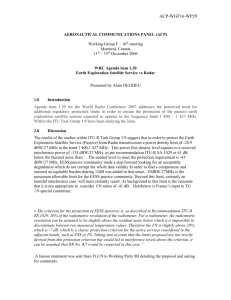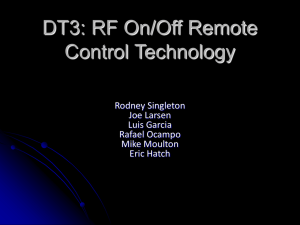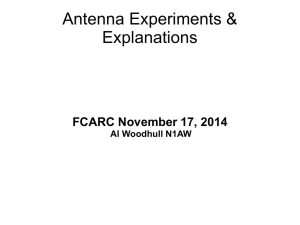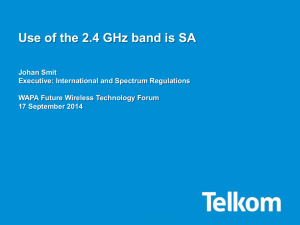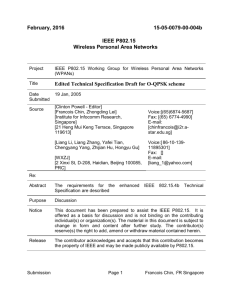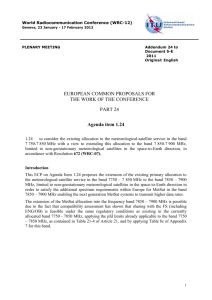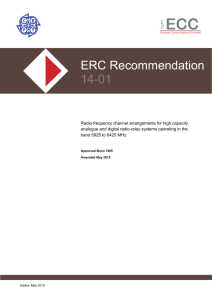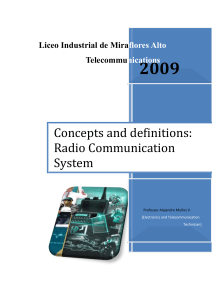Current 13/14GHz capacities and bandwidths (ref
advertisement
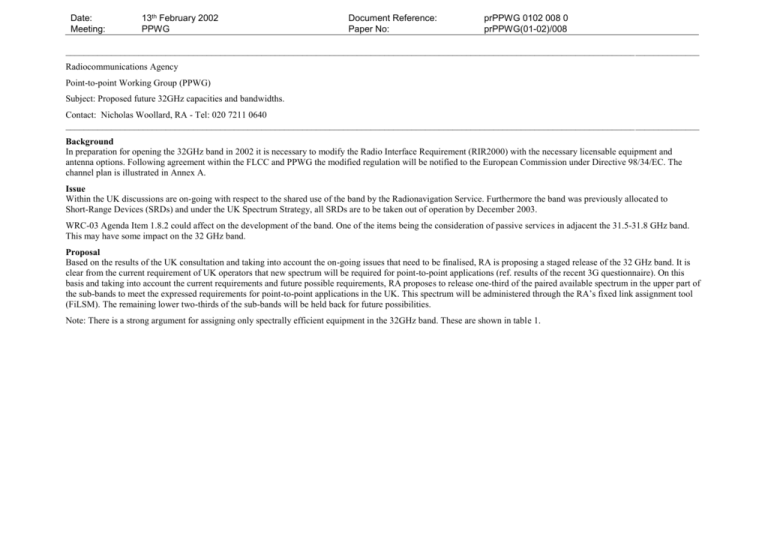
Date: Meeting: 13th February 2002 PPWG Document Reference: Paper No: prPPWG 0102 008 0 prPPWG(01-02)/008 _____________________________________________________________________________________________________________________________ ______________ Radiocommunications Agency Point-to-point Working Group (PPWG) Subject: Proposed future 32GHz capacities and bandwidths. Contact: Nicholas Woollard, RA - Tel: 020 7211 0640 _____________________________________________________________________________________________________________________________ ______________ Background In preparation for opening the 32GHz band in 2002 it is necessary to modify the Radio Interface Requirement (RIR2000) with the necessary licensable equipment and antenna options. Following agreement within the FLCC and PPWG the modified regulation will be notified to the European Commission under Directive 98/34/EC. The channel plan is illustrated in Annex A. Issue Within the UK discussions are on-going with respect to the shared use of the band by the Radionavigation Service. Furthermore the band was previously allocated to Short-Range Devices (SRDs) and under the UK Spectrum Strategy, all SRDs are to be taken out of operation by December 2003. WRC-03 Agenda Item 1.8.2 could affect on the development of the band. One of the items being the consideration of passive services in adjacent the 31.5-31.8 GHz band. This may have some impact on the 32 GHz band. Proposal Based on the results of the UK consultation and taking into account the on-going issues that need to be finalised, RA is proposing a staged release of the 32 GHz band. It is clear from the current requirement of UK operators that new spectrum will be required for point-to-point applications (ref. results of the recent 3G questionnaire). On this basis and taking into account the current requirements and future possible requirements, RA proposes to release one-third of the paired available spectrum in the upper part of the sub-bands to meet the expressed requirements for point-to-point applications in the UK. This spectrum will be administered through the RA’s fixed link assignment tool (FiLSM). The remaining lower two-thirds of the sub-bands will be held back for future possibilities. Note: There is a strong argument for assigning only spectrally efficient equipment in the 32GHz band. These are shown in table 1. Proposed 32GHz capacities and bandwidths Frequency Range (MHz) 31800 – 33400 (within sub-bands: 32319 – 32571MHz duplexed with 33131 – 33383MHz only) Channel plan The Channel Plan is in accordance with CEPT Recommendation T/R 01-02 E Equipment Reference Code Part A Part B Part C 8M 16M 34M 51M 140M1 140M2 140M 3M5 7M 14M 14M 28M 28M 56M A1 B2 - Minimum Bit Rate (Mbits/s) 8 2x8 34 51 140/155 140/155 140/155 Channel Spacing (MHz) 3.5 7 14 14 28 28 56 Output Power Reference Standards Frequency Assumed to be fulfilled in frequency Assignment Criteria planning and defining the equipment type Minimum Maximum Power Power (dBm) (dBm) +30 EN 300 197 V1.3.1 (2001 –10) Fixed Radio Systems; Point-to-Point +30 Equipment; Parameters for radio systems for +30 the transmission of digital signals operating at +30 32 and 38 GHz. +30 +30 +30 1 This Licence Class is for Adjacent Channel Alternate-Polarisation (ACAP) operation only. 2 This Licence Class is for Adjacent Channel Co-Polarisation (ACCP) operation only. RA xxx (TBA) Additional Information Currently, assignments are available in the upper third of the two sub-bands (32319 – 32571MHz duplexed with 33131 – 33383MHz) only. Annex A: Proposed UK 32GHz Band plan (ERC 01-02 E) 71 MHz 140 MHz 45 MHz 4 x 56MHz channels 4 x 56MHz channels 32319MHz 33131MHz 32543 MHz 15 MHz 32683 MHz 56 MHz 17 MHz 9 x 28MHz channels 15 MHz 9 x 28MHz channels 56 MHz 18 x 4MHz channels 15 MHz 18 x 4MHz channels 56 MHz 36 x 7MHz channels 15 MHz 36 x 7MHz channels 56 MHz 72 x 3.5MHz channels 72 x 3.5MHz channels 32319MHz 31800 MHz 33131MHz 32571 MHz 32627 MHz 33400 MHz UK 32GHz band plan (ERC 01-02 E compatible) = Guard bands = Centre gap Not to scale.


